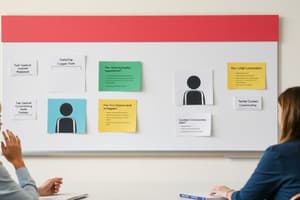Podcast
Questions and Answers
What is considered a form of non-verbal communication?
What is considered a form of non-verbal communication?
- Public speaking
- Body language (correct)
- Text messaging
Verbal communication includes only written forms.
Verbal communication includes only written forms.
False (B)
What are the two basic types of communication?
What are the two basic types of communication?
Non-verbal communication and Verbal communication
In Laswell's model of communication, the flow of communication goes from sender to message, to medium, to _______ and then to effect.
In Laswell's model of communication, the flow of communication goes from sender to message, to medium, to _______ and then to effect.
Match the forms of communication with their description:
Match the forms of communication with their description:
What do Wesley and Maclean identify as crucial for effective communication?
What do Wesley and Maclean identify as crucial for effective communication?
Noise is only a factor in technical communication.
Noise is only a factor in technical communication.
What are the two contexts in which Wesley and Maclean's model of communication can be applied?
What are the two contexts in which Wesley and Maclean's model of communication can be applied?
Communication starts when a person effectively responds to their __________.
Communication starts when a person effectively responds to their __________.
Match the elements of Wesley and Maclean's model with their descriptions:
Match the elements of Wesley and Maclean's model with their descriptions:
Flashcards are hidden until you start studying
Study Notes
Communication Overview
- Communication encompasses the act of expressing or exchanging information using words, sounds, signs, or behaviors.
Types of Communication
Non-verbal Communication
- Includes signs, gestures, symbols, body language, colors, and facial expressions.
Verbal Communication
- Consists of oral and written forms.
Models of Communication
Laswell's Model
- Describes communication as a linear process: Sender ➡️ Message ➡️ Medium ➡️ Receiver ➡️ Effect.
Wesley and Maclean's Model
- Highlights that communication begins when a person responds to their environment, encompassing feedback, advocacy, and audience interaction.
Osgood-Schramm Model
- Depicts communication as a circular process, where encoding, sending, and decoding messages occur in continuous interaction between sender and receiver.
David Berro's Communication Model
- Follows the SMRC model, acknowledging factors influencing message transmission and reception.
Communication Elements
- Incorporates communication skills, content, attitudes, social systems, and cultural codes impacting message interpretation.
Media Literacy
- Defined as the ability to access, analyze, evaluate, and create media across various platforms like television, radio, and the internet.
- Enhances critical thinking, discernment of factual information, and competency in media processing.
Importance of Information Literacy
- Equips learners to gather relevant information, evaluate sources, and cope with data overload effectively.
Technology Literacy
- Refers to the ability to use modern technology to manage, evaluate, create, and communicate information effectively.
- Essential for informed decision-making and navigating the digital landscape.
Information Management
- Involves identifying information needs, sourcing credible material, and utilizing it ethically and efficiently.
Sources of Information
- Scholarly Publications: Peer-reviewed articles for academic audiences.
- Popular Publications: General audience content, lacking in-depth citations.
Organizing Information
- Categorization involves grouping and tagging for easier access and retrieval.
Ethical Use of Information
- Emphasizes fairness, respect, accuracy, and transparency in using and communicating data.
Information Literacy Definition
- The skill set that allows individuals to find, understand, and wisely utilize information.
Key Processes in Information Literacy
- Research existing knowledge, develop questions, observe and gather data, analyze findings, and formulate conclusions.
Communication Channels
- Encompass academic journals, conferences, online platforms, media, and professional networks.
Context and Relevance of Information
- Assessing timeliness and context is crucial in determining information validity, especially in rapidly changing fields.
Studying That Suits You
Use AI to generate personalized quizzes and flashcards to suit your learning preferences.




